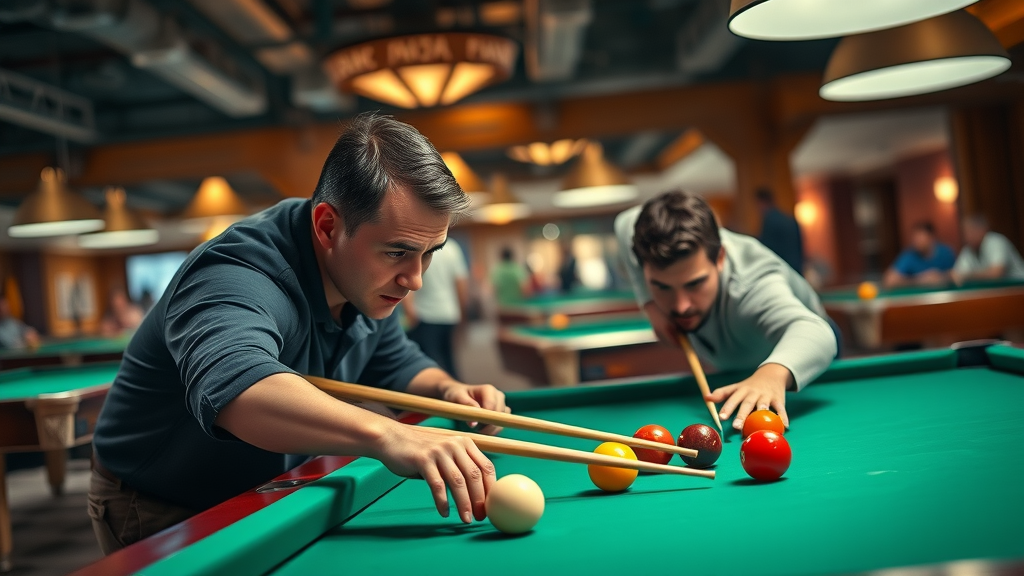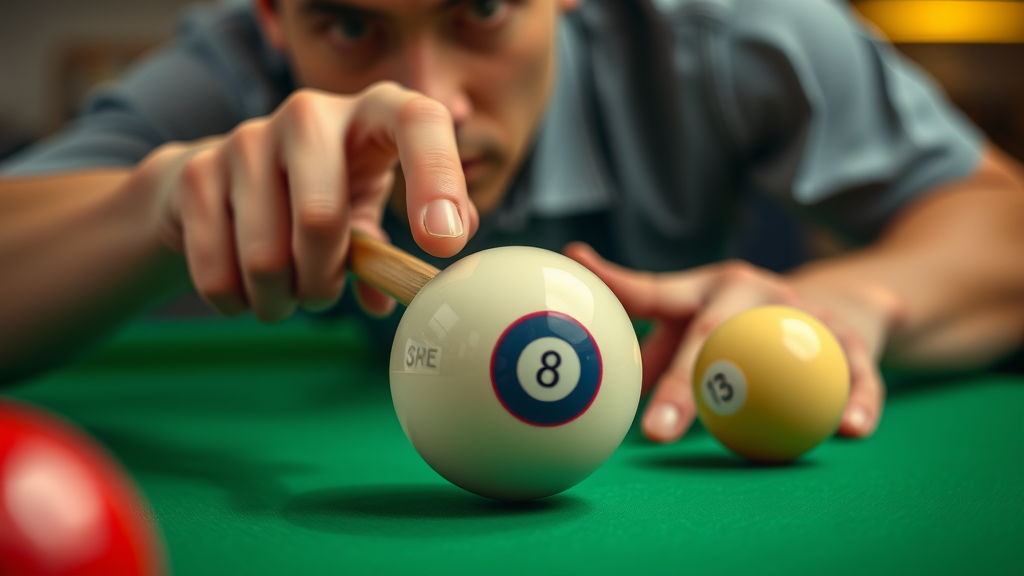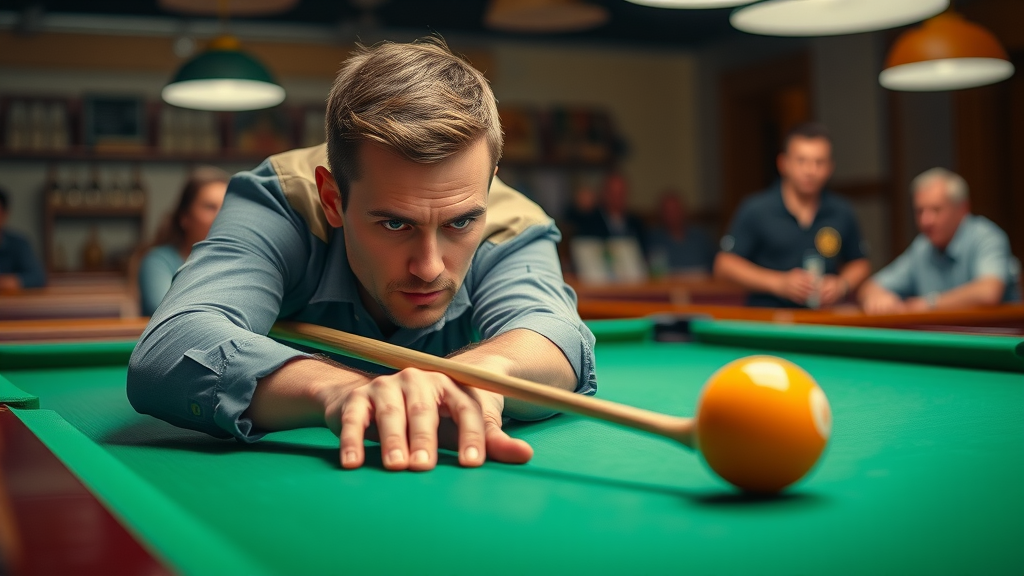Are you frustrated by missed shots and inconsistent wins in your pool game? Here’s a surprising fact: over 80% of missed opportunities in amateur billiards come down to poor shot selection, not flawed technique. Whether you’re a beginner or an intermediate player, billiards shot selection is the game-changing skill that separates casual players from consistent champions. In this comprehensive, step-by-step guide, you’ll discover how to analyze every angle, optimize cue ball control, and develop a winning mindset for every stroke.

Can Billiards Shot Selection Make or Break Your Game? Surprising Facts Revealed
It may come as a shock, but studies and pro observations agree: billiards shot selection plays a more critical role than raw shot-making ability at most skill levels. Imagine this: You’ve spent hours perfecting your stroke and striking the cue ball cleanly, only to misread the table and leave yourself out of position after a successful pot. Seasoned players know that choosing the right shot for each layout is what creates consistent run-outs and high-percentage wins.
- Did you know that over 80% of missed opportunities in amateur billiards come down to poor shot selection, not faulty technique? Learn why mastering billiards shot selection is the ultimate skill to elevate your strategy.
By understanding how to analyze your options and anticipate the results of each shot, you’ll start playing chess instead of checkers—with every stroke bringing you closer to total table control. Let’s break down the skills that give you an edge in shot selection .
Essential Skills for Billiards Shot Selection: Understanding the Basics

- Billiards shot selection fundamentals
- Pool table layout awareness
- Cue ball control principles
- Ball control technique
Every game of billiards is a puzzle. To solve it, you’ll need to combine four critical skills: understanding the layout of the balls on the pool table, controlling the cue ball precisely, choosing the right stroke, and reading table conditions. Foundational awareness of the pool table means noting every detail: open lanes, ball clusters, pocket positions, and how the cue ball will react after contact. Billiards shot selection begins with mentally mapping the possible pathways and predicting which one sets up your next shot best.
Additionally, cue ball control is king. By mastering how to strike the cue ball to control its path and speed, you set yourself up for success not just for one shot, but for the entire sequence. Ball control isn’t just about pocketing a ball—it’s about leaving yourself optimally positioned for the next play. Mastering these basics transforms every stroke from a gamble into a calculated move.
Why Shot Selection Matters: Real-World Impact on Match Outcomes
“The difference between a beginner and a seasoned player is rarely their stroke—it’s their billiards shot selection.” – Pro Coach
Imagine two players with equal cue skills: the one who consistently chooses the smartest shots will win more games. Shot selection shapes the flow of a billiards match. A calculated approach not only increases your odds of pocketing the current object ball but also keeps the cue ball in favorable positions. Poor decisions can quickly turn the tide, costing you advantageous positions or handing your opponent easy run-outs.
The power of intelligent shot selection shows up in close matches, where just one misjudged shot can make all the difference. Practicing this skill boosts your confidence, giving you an edge in tense game situations. By focusing on the science of shot selection, you’ll evolve from simply reacting to the table to controlling the table itself.
Elements of Effective Billiards Shot Selection: Analyzing the Table
A great pool player doesn’t just see balls to be sunk—they see opportunities. Effective billiards shot selection starts with a careful analysis of the pool table. Each shot is influenced by the layout, your skill level, and the opponent’s strengths and weaknesses. Developing an eye for these details allows you to quickly identify both high-percentage shots and critical safety plays that keep you in control.
Beyond simple observation, train yourself to look for patterns: Which balls are clustered? Where are the open lanes? Can you clear a problem area now, or should you position the cue ball first? The better you read the table, the more accurately you can plan your moves and pre-empt potential pitfalls.
Assessing the Pool Table: Identifying Shot Opportunities

The first step in billiards shot selection is a deliberate assessment of the pool table. Stand behind your shot and survey not just the ball you intend to pot, but every other ball’s position. Are any balls blocking a pocket? Is the target ball close to another, complicating your angle? Take stock of the cue ball , object balls, and any possible interference.
Visualize pocketing a ball and where the cue ball will finish. Sometimes, the highest percentage shot is not immediately obvious; it may be smarter to play a safety or open up a cluster, setting yourself up for future shots. Consistent assessment ensures you’re always one step ahead and never caught by surprise.
Visualizing Ball Pathways & Predicting Outcomes
Now that you’ve assessed the layout, it’s time to visualize. Before striking the cue ball, mentally trace the intended shot path. See the cue tip contact point on the cue ball, the line to the object ball, and the predicted route to the pocket. Envision the cue ball’s journey after the shot—will it have enough spin or speed for the next shot? Mapping ball pathways reduces guesswork and helps you anticipate challenges before they happen.
Pro players routinely walk around the billiard table, viewing shots from different angles and predicting potential outcomes based on subtle table conditions. This step allows for higher accuracy and boosts shot confidence, transforming complex tables into solvable puzzles.
Cue Ball Control and Positioning: The Core of Billiards Shot Selection

Many beginners focus solely on pocketing the object ball, but advanced players know the real magic lies in cue ball control. Mastering the cue ball is what turns average players into table dominators. Evaluate the desired path of your object ball, then ask: Where should the cue ball stop for my next shot? The art of predicting and achieving precise cue ball positions is the difference between running the table and leaving yourself stuck after a perfect shot.
If you want to give yourself an edge in any billiards game, prioritize practicing the science of positioning the cue ball after every stroke. This level of foresight forces you to plan ahead, aiming not just for the immediate reward but thinking two or even three shots into the future—an approach every tournament winner swears by.
Mastering Cue Ball Control for Better Shot Selection
Developing effective cue ball control begins at the contact point between the cue tip and the cue ball. The spot where you strike the cue ball determines both speed and spin, affecting where it travels after hitting the object ball. Using proper technique—smooth follow-through with your pool cue, precise aim, and a consistent stroke—gives more predictability and command.
Drills to improve this control include practicing draw shots (striking low on the cue ball for backspin), follow shots (high on the cue ball for forward roll), and side spin shots. The goal: always leave the cue ball in an ideal position for your next objective, minimizing tough banks and maximizing clear shots. Strategic cue ball control is a hallmark of excellent billiards shot selection .
Positioning the Cue Ball: Strategies for Next-Shot Advantage
Positioning the cue ball doesn’t end with a single great shot—it’s a continuous process that governs your entire sequence. When you plan for position, use the ideal angle that will make the next shot easy, not just possible. Pay attention to table conditions: rails, pockets, and obstacles on your route. Experiment with different cue tip contact points to achieve the right amount of draw, follow, or left/right spin.
Advanced players continually think, “How do I position the cue ball for the lowest-risk option?” This proactive approach creates runs of two, three, or more balls. Even under pressure, these habits ensure you retain control, keeping your opponent on defense and boosting your confidence in competitive play.
Ball Control Techniques: Consistency in Billiards Shot Selection
- Soft vs. Hard Strokes: Learning to vary the force of your shot is critical. Soft strokes give fine control and are ideal for precise cue ball placement. Hard strokes can break up clusters or cover longer distances, but increase risk of error.
- Managing Spin: Ball control is not just about direction and strength, but also how you apply spin using the cue tip. Mastering top, bottom, and side spins unlocks advanced position play and opens new shot selection options.
- Reading Table Conditions: Every pool table plays differently depending on surface, cloth speed, chalk, and humidity. Take a moment in practice to test cue ball reaction and adjust your shot selection for optimal results.
| Error | Result | How to Fix |
|---|---|---|
| Hitting the cue ball too hard | Loss of position control; missed shots | Use a controlled, softer stroke focusing on cue tip precision |
| Incorrect cue tip contact point | Unwanted spin or misdirection | Practice consistent aim and experiment with hitting above, below, or beside center |
| Overlooking table speed | Cue ball runs too far or stops short | Test table speed before playing, adjust shot force as needed |
Understanding Types of Billiards Shots for Better Shot Selection
A true master of billiards shot selection understands diverse shot types and when to deploy them for maximum effect. From aggressive break shots to subtle safety plays, each stroke has a purpose. Knowing which shot matches your situation creates flexibility and gives you a toolkit for every possible table layout.
Let’s examine some key types of shots that will expand your strategic range and help you control both the object ball and the cue ball with greater intent.
Break Shot: Starting Strong for Strategic Shot Selection

The break shot is the opening move of every billiards game—a powerful chance to shape the table’s future. A well-executed break can scatter the balls ideally, leaving you open shots and early control. Top players know that a strong break isn’t about power alone. It’s about hitting the cue ball squarely, choosing the right spot on the rack, and positioning the cue ball for your next shot. If you can control the cue ball on the break, you’ll enjoy better setups and higher-scoring runs from the start.
Regularly practicing this shot with attention to cue tip placement and table speed leads to consistency and can turn a game around before your opponent even has a chance to shoot.
Bank Shot: Adding Versatility to Your Shot Choices

The bank shot is an essential element of strategic play, expanding your potential shot paths and giving you tactical options when direct shots are blocked. By striking the object ball so it rebounds off a cushion before heading to the pocket, you open up table layouts and can often save a run that looks lost to most players.
To master bank shots, focus on understanding angles, practicing aim, and adjusting for speed and table conditions. Advanced players use bank shots for both offensive runs and clever safety plays, using the cushion to set up a future advantage. Including this shot in your routine drastically increases your success and flexibility in tough situations.
Jump Shot and Draw Shot: Advanced Options in Billiards Shot Selection
Jump shots and draw shots represent the next level of billiards mastery. A jump shot is used when the cue ball must leap over an obstructing ball, requiring precision with both speed and cue tip angle. While risky, the shot opens new avenues on a crowded table and can save an otherwise impossible turn.
The draw shot is all about backspin. By striking below the center of the cue ball with your pool cue, the cue ball spins backward after hitting the object ball. This technique enables you to position the cue ball perfectly for the next shot, especially in tight table conditions. Advanced players spend hours perfecting these shots for high-pressure moments when billiards shot selection is the sole path to victory.
Developing a Winning Strategy: Step-by-Step Approach to Billiards Shot Selection
- Evaluate the pool table layout: Before each shot, survey all balls on the table and plan possible outcomes.
- Plan three shots ahead: Think beyond the current stroke. Anticipate where the cue ball will end up for future shots.
- Prioritize cue ball control: Always choose position play over flashy shots for long-term consistency.
- Choose the lowest-risk shot: Minimize errors by selecting options with the highest chances of success.
- Adapt when balls are clustered: Be ready to change your plan if a cluster or unexpected table condition arises.

“Strategy isn’t guessing—it’s about making the next shot easier, every time.” – Tournament Winner
Combining foresight with adaptability is the signature of top billiards players. Each movement should aim to reduce your risks, maximize scoring potential, and keep the pressure on your opponent. By following this systematic approach, you’ll move from guesswork to reliable, repeatable results.
Common Mistakes in Billiards Shot Selection & How to Avoid Them
- Rushing decisions: Allowing adrenaline to dictate your timing can lead to impulsive, low-percentage shots.
- Ignoring safety play: Sometimes, a defensive shot is your best offense. Learn to recognize when to play safe.
- Underestimating table speed: Each pool table reacts differently. Failing to adapt results in lost cue ball control.
- Poor cue ball control: Neglecting position play frequently leads to missed shots and difficult setups for your next turn.
Awareness of these common pitfalls greatly increases your billiards shot selection skills by helping you slow down, evaluate your options, and take control of the table instead of reacting blindly each round.
Improving Billiards Shot Selection: Practice Drills and Pro Tips
- Cue ball positioning drills: Practice shooting different object balls while positioning the cue ball accurately for specific spots.
- Bank shot accuracy exercises: Set up routine bank shots and adjust your angles and speed for consistency.
- Tactical break shot practice: Rehearse various break shot positions and forces, tracking cue ball reaction each time.
- Jump shot control routines: Use controlled jump shots over obstacles to enhance technique and confidence.
Regularly incorporating these drills into your practice routine will reinforce core principles of shot selection and gradually increase your confidence and performance under real game conditions.
How to Self-Analyze and Review Your Billiards Shot Selection
Self-analysis is critical for ongoing improvement. After each session or match, review not just the shots you missed but especially the shots you chose. Did you have a better option? Could you have played safer or positioned the cue ball more effectively? Many top players use video analysis to break down their shot choices and outcomes.
If you don’t have access to video, note in a journal each time a shot didn’t work out as planned and examine why. Over time, patterns will emerge, allowing for targeted practice and fewer repeated mistakes. This reflective approach transforms each loss into a lesson and every win into a stepping stone toward mastery.
Case Studies: Billiards Shot Selection Lessons from the Pros
Few things illustrate the power of expert shot selection like real-life examples from the world’s best players. Studying pro matches, you’ll see careful planning, precise cue ball control, and strategic risk assessment on every shot. Breakdowns of major tournament wins reveal that the turning point in many games isn’t flashy trick shots—it’s the calculated decision that keeps the run alive or changes the tempo of the match.
The collective wisdom from legendary players and seasoned coaches is clear: Focused attention on every detail, from the contact point with the cue tip to post-shot positioning, elevates ordinary players into consistent winners. Their process is repeatable—study their routines, and integrate their habits into your own game for measurable improvement.
How Champions Leverage Cue Ball Control for Consistent Wins
The world’s top players obsess about cue ball control. Through relentless practice, they’ve developed subconscious habits: aiming to leave the cue ball in the “zone” for the next shot, using side spin to navigate tough layouts, and minimizing cue stick movement for consistent, repeatable strokes. Notably, these champions often choose safety options over low-percentage aggressive shots, especially when the runout isn’t there.
Adopting similar habits is possible at any skill level. Break down pro matches focusing solely on the cue ball. Note where it stops after each shot and how it sets up the next move. Imitate these patterns in your own practice for dramatic improvements in your game outcomes.
Community Insights: Best Advice for Novices on Billiards Shot Selection
“The biggest leap comes when you start thinking two or three shots ahead.” – Hall of Fame Inductee
Billiard communities often agree: The true turning point for most developing players comes when they embrace strategic thinking. Novices tend to focus solely on making each shot, while advanced players always ask, “Where will the cue ball land, and what does that mean for my next move?” Setting achievable goals, staying patient, and regularly documenting your progress are universal recommendations from experienced players worldwide.
Through forums, coaching clinics, and friendly competition, you can accelerate your learning—seek advice, share your own challenges, and observe others’ approaches to billiards shot selection .
People Also Ask: Essential Billiards Shot Selection Questions
What are the shots in billiards?
- Billiards includes different shots such as the break shot, bank shot, draw shot, jump shot, and more. Effective billiards shot selection involves knowing when and how to use each to gain the upper hand.
What is a good shot selection?
- Good billiards shot selection means choosing the stroke that maximizes your chance of sinking a ball and positioning the cue ball for the subsequent shot, considering both difficulty and risk.
What is the hardest billiard shot?
- The hardest billiard shot often involves cue ball control under pressure—such as a precise jump shot or a tough combination bank shot, especially with limited ball control and table space.
What is the 2 shot rule in pool?
- The 2 shot rule in pool allows the incoming player two attempts to pot a ball after a foul. This impacts billiards shot selection by offering more strategic choices for table control.
Frequently Asked Questions about Billiards Shot Selection
- How do I develop better cue ball control?
- What's the fastest way to improve shot selection skills?
- Do pros always plan several shots ahead?
Key Takeaways: Elevate Your Billiards Shot Selection Today
- Prioritize cue ball control for seamless shot transitions
- Study and practice multiple shot types to expand your options
- Review and analyze your own games to refine your shot selection
- Think ahead—map your table and plan your strategy
Next Steps to Master Billiards Shot Selection and Dominate Your Opponents
- Ready to transform your billiards shot selection? Commit to practicing daily, studying professional games, and consistently reassessing your approach.
 Add Row
Add Row  Add
Add 


Write A Comment